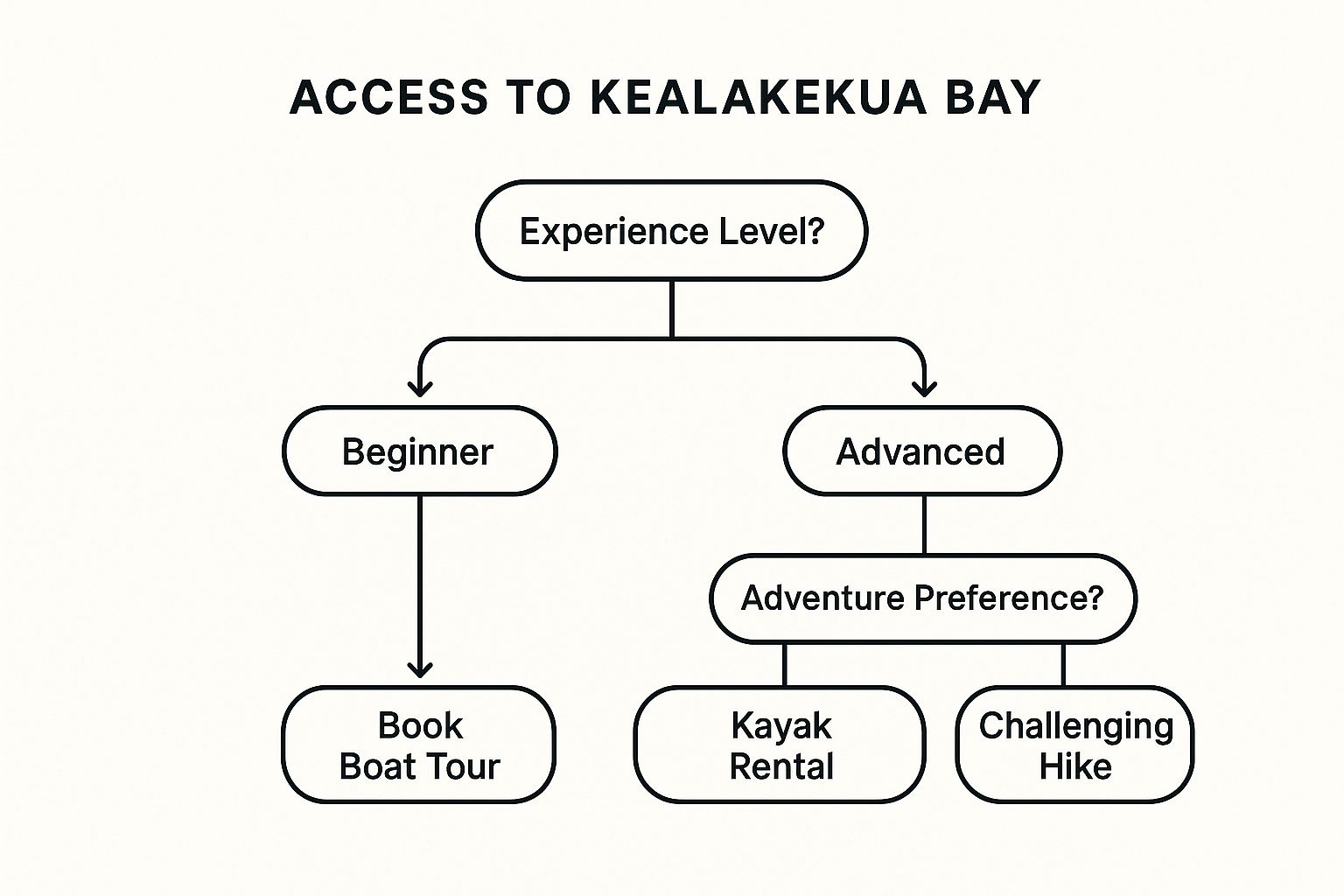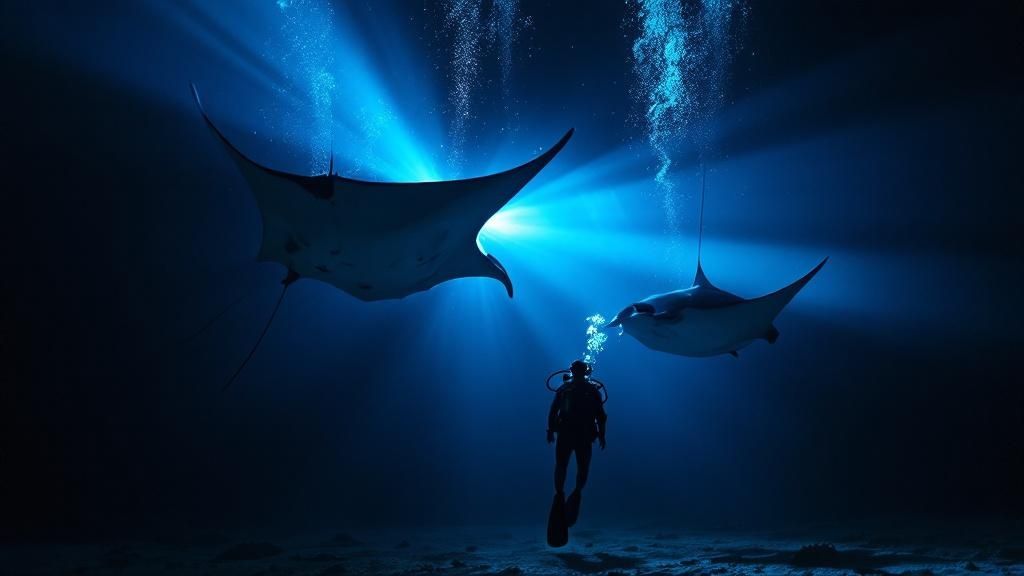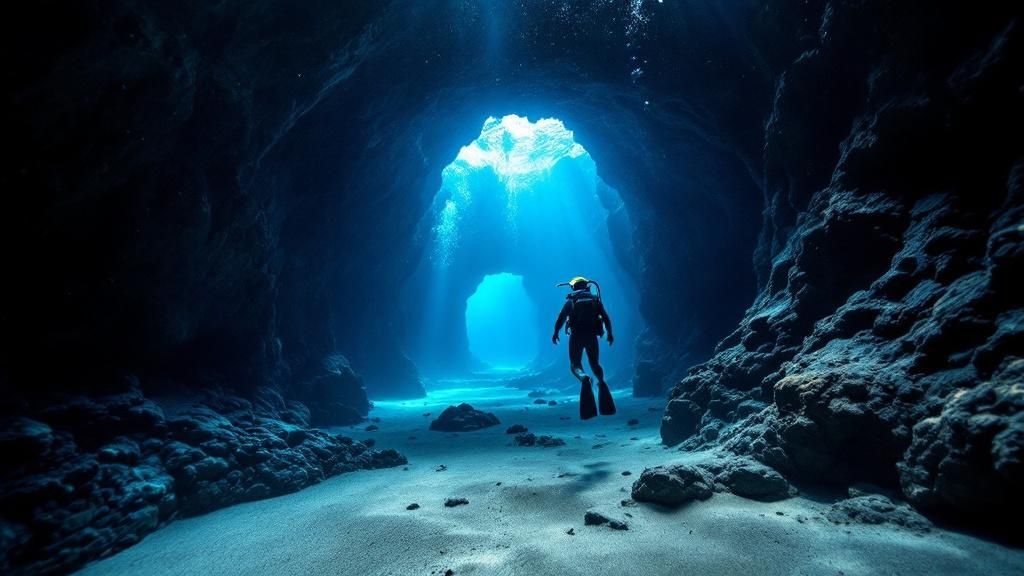Getting Started
Scuba diving the Big Island of Hawaii offers some of the most unique and vibrant underwater experiences in the world, from famous manta ray night dives to exploring submerged lava tubes. This guide is designed to be your comprehensive resource for planning the ultimate Big Island diving adventure. We will move beyond generic descriptions to provide practical, in-depth analysis of the top dive sites, charter companies, and specialty dives available.
You will learn how to choose the right excursions for your skill level, what to expect from iconic experiences like black water dives, and where to find the best training and equipment. We will analyze the specific offerings of top-rated Kona diving companies, helping you find the perfect fit whether you're a novice or a seasoned pro. This detailed breakdown ensures you can confidently plan every aspect of your trip. As you begin planning your trip, you might also find a general Big Island marine adventure guide helpful for broader exploration. This resource will help you make the most of your time exploring the incredible marine ecosystems of Hawaii's Big Island.
1. Kealakekua Bay Marine Life Conservation District
As one of Hawaii's premier marine sanctuaries, Kealakekua Bay is a non-negotiable destination for anyone serious about Big Island scuba diving. This protected area boasts some of the most pristine conditions in the state, with visibility often exceeding 100 feet. Its status as a Marine Life Conservation District means its coral reefs are exceptionally vibrant and teeming with life, creating a natural aquarium environment. Divers can expect to encounter large pods of spinner dolphins and abundant Hawaiian green sea turtles (honu) in their natural habitat.
The bay is not accessible by car, which helps preserve its untouched quality. This unique access challenge requires planning, as divers must arrive via a boat tour, kayak, or a strenuous hike. For this reason, it is considered a special trip and is an excellent choice for divers wanting a truly memorable underwater experience away from more crowded sites.
The following decision tree helps illustrate the best way for you to access the bay based on your experience and preferences.

The infographic highlights that while beginners should opt for guided boat tours for safety and convenience, advanced divers have more adventurous options like kayaking or hiking to the site. Regardless of your access method, early morning departures are highly recommended to enjoy the calmest waters and peak marine activity. To see if this iconic site is on an upcoming itinerary, you can learn more about the dive sites of Kealakekua Bay and other premier Kona locations on Kona Honu Divers' website.
2. Manta Ray Night Dives
The world-renowned Manta Ray Night Dive is an essential, almost surreal, part of any Big Island scuba diving itinerary. This unique nocturnal event allows participants to witness dozens of giant Pacific manta rays gracefully feeding on plankton. These gentle giants, with wingspans that can exceed 15 feet, glide inches from divers in a mesmerizing underwater ballet. Operators establish a "campfire" of powerful lights on the ocean floor, which attracts plankton and, in turn, the mantas, creating one of the most reliable and spectacular large-animal encounters on the planet.

This dive is not about exploring a reef; it's a stationary experience focused entirely on observation. Divers descend to a sandy bottom, position themselves around the light source, and simply watch the spectacle unfold. The primary sites, such as Manta Village and Manta Heaven, are known for consistent manta activity, making this a highly dependable dive. For those eager to witness this incredible spectacle, further information on the Manta Ray Night Dive can be found here.
To ensure a safe and respectful interaction, it is crucial to book with a reputable operator that adheres to strict Manta Tour Operator Standards. Guidelines are simple but vital: remain stationary on the bottom, avoid shining your dive light directly into the mantas' eyes, and never touch them. By staying calm and still, you allow the mantas to approach comfortably, often resulting in incredibly close passes. This unforgettable experience solidifies Kona's reputation as a premier destination for marine wildlife encounters.
3. Black Water Diving
For a truly unique and otherworldly adventure, nothing compares to a black water dive, a signature experience in Big Island scuba diving. This advanced dive takes you offshore into the deep, dark waters of the Kona coast at night. Suspended from a tether in the open ocean, you'll witness the planet's largest daily migration as countless deep-sea creatures ascend towards the surface. It's a surreal encounter with life forms that are rarely, if ever, seen in the light of day.
This specialized dive is not for the faint of heart and requires a solid foundation in dive skills, particularly excellent buoyancy control. As you float in the darkness, you'll be surrounded by a mesmerizing display of bioluminescence and encounter bizarre and beautiful pelagic organisms. Expect to see translucent larval fish, ethereal jellyfish, intricate siphonophores, and maybe even a rare paper nautilus. It is an unparalleled opportunity for macro photographers and marine biology enthusiasts to observe an ecosystem that feels alien and magical.
Because of its advanced nature, it's critical to go with an experienced charter that has perfected the safety protocols for this type of dive. Operators like Jack's Diving Locker pioneered this dive on the island, but other reputable companies now offer it. To prepare, ensure you have an advanced certification, practice your buoyancy, and move slowly and deliberately to avoid disturbing the delicate organisms you’ll encounter. You can discover more about what this incredible dive entails and book your own trip by learning about a Big Island Black Water Dive.
4. Coral Restoration Projects and Volunteer Opportunities
For divers passionate about conservation, participating in coral restoration projects offers a uniquely rewarding form of Big Island scuba diving. These initiatives allow you to move beyond observation and actively contribute to the health of Hawaii's precious marine ecosystems. Volunteers work alongside marine biologists and conservation experts on tasks like out-planting nursery-grown coral fragments onto degraded reefs, conducting scientific monitoring surveys, and participating in marine debris removal dives. This hands-on approach provides a much deeper connection to and understanding of the underwater world.
These opportunities are not just for scientific divers; many local organizations welcome certified recreational divers who want to make a difference. Programs often start with essential training workshops to ensure volunteers follow strict protocols that protect both the divers and the delicate coral. Participating in these projects, such as those organized by The Nature Conservancy Hawaii or in partnership with local dive shops, transforms a dive trip into a meaningful act of environmental stewardship, leaving a positive and lasting impact on the island's reefs.
Engaging in this work requires planning, as volunteer spots can be limited and may require pre-registration. It is a perfect choice for eco-conscious travelers and divers looking to add purpose to their passion. To find out how you can get involved and what is required to participate, you can learn more about coral restoration projects and volunteer opportunities on the Big Island and see how you can contribute to preserving this fragile paradise for future generations.
5. Underwater Lava Formations and Geological Diving
The Big Island’s identity is forged by fire, and this volcanic legacy creates a truly unique environment for Big Island scuba diving. The island's dynamic geology has sculpted an underwater world of dramatic topography, offering divers a chance to explore landscapes found nowhere else on earth. Imagine gliding through ancient lava tubes, navigating intricate underwater arches, and descending along steep black sand slopes formed by millennia of volcanic activity. This type of diving is less about spotting specific animals and more about immersing yourself in the raw, powerful architecture of the ocean floor.
Exploring these formations requires specific skills and awareness. Excellent buoyancy control is non-negotiable to avoid stirring up fine volcanic sediment or making contact with the sharp, abrasive lava rock. For those venturing into overhead environments like lava tubes or caverns, specialized training such as a cavern diving certification is highly recommended for safety. Proper equipment, including powerful dive lights and gear resistant to abrasion, is also crucial for a successful and safe geological dive.

This type of diving is ideal for the adventurous diver seeking an experience beyond typical reef tours. Sites like the lava tubes along the South Kona coast provide a thrilling sense of exploration, while the arches near Kealakekua Bay offer stunning photographic opportunities. These geologically rich sites showcase the foundational forces that shaped the Hawaiian Islands. To discover which charters visit these unique topographies, you can explore more about the most beautiful Kona diving sites on Kona Honu Divers' website.
6. Marine Life Photography and Macro Diving Workshops
For divers looking to bring home more than just memories, specialized marine life photography and macro diving workshops offer a unique way to engage with the underwater world. These programs are designed for divers who want to develop their artistic and technical skills, combining advanced buoyancy control with the principles of underwater photography. This specialized focus transforms a standard dive into a creative mission, teaching participants to capture the stunning details of the Big Island’s smallest and most fascinating inhabitants, from vibrant nudibranchs to elusive crustaceans.
Participating in a workshop is one of the most effective ways to accelerate your learning curve in underwater photography. Instructors provide real-time feedback on composition, lighting, and technique while helping you find incredible subjects you might otherwise miss. These focused dives are perfect for both beginners starting with a simple point-and-shoot and advanced photographers fine-tuning their DSLR systems. By mastering skills like predicting animal behavior and maintaining perfect buoyancy, you can elevate your Big Island scuba diving experience, creating powerful images that tell the story of the reef. These workshops are ideal for anyone passionate about both diving and art.
7. Dolphin Encounter Diving Experiences
Observing dolphins in their natural environment is a highlight of any trip, and Big Island scuba diving offers unparalleled opportunities for these ethical encounters. These experiences focus on respectful observation of Hawaiian spinner dolphins, pilot whales, and other cetaceans. Rather than an aggressive pursuit, reputable tours prioritize the animals' well-being, providing an educational backdrop on dolphin behavior, conservation, and the crucial marine mammal protection guidelines that keep them safe. The goal is a passive interaction where divers can witness these intelligent creatures as they rest, travel, or play.
These encounters often happen organically during dive trips to sites like Kealakekua Bay, where spinner dolphins frequently rest in the calm, protected waters. The key is choosing an operator that strictly adheres to NOAA regulations, maintaining a safe and respectful distance. This patient approach not only protects the animals but often results in more profound and lengthy observations, as undisturbed dolphins are more likely to display natural behaviors and occasionally approach divers out of their own curiosity.
This method is ideal for marine life enthusiasts and underwater photographers who want to witness cetaceans behaving naturally without causing distress. The focus is on observation, not interaction, which is a critical distinction for responsible wildlife tourism. By following guidelines, such as avoiding flash photography and never swimming directly at the animals, divers contribute to the long-term health of these vital populations. To understand the best practices for these interactions, you can read more about responsible and ethical diving with dolphins in Kona, Hawaii on konahonudivers.com.
Big Island Scuba Diving Experiences Comparison
| Experience/Location | Core Features / Highlights | User Experience ★ | Target Audience 👥 | Unique Selling Points ✨ | Price / Value 💰 |
|---|---|---|---|---|---|
| Kealakekua Bay Marine Life Conservation | 100+ ft visibility, protected sanctuary, diverse reefs | ★★★★★ excellent clarity & biodiversity | Beginners to advanced divers | Historical site, year-round calm waters | $$ Moderate, permit needed |
| Manta Ray Night Dives | Guaranteed sightings, night dive with lights | ★★★★½ unique, thrilling wildlife encounter | Divers & snorkelers | Close manta interactions, research support 🏆 | $$$ Higher price, popular |
| Black Water Diving | Deep night dives, rare pelagic, bioluminescence | ★★★★ cutting-edge, scientifically rich | Advanced certified divers | Rare species, intense experience ✨ | $$$ Premium, specialized |
| Coral Restoration & Volunteer Opportunities | Hands-on coral work, reef monitoring, eco education | ★★★★ meaningful, skill-building | Eco-conscious divers & volunteers | Conservation impact, marine research collaboration | $ Low to moderate; training |
| Underwater Lava Formations & Geological | Lava tubes, volcanic arches, evolving landscapes | ★★★★ visually stunning, adventurous | Advanced / cavern certified divers | Unique geology, volcanic underwater features ✨ | $$ Moderate, advanced skill |
| Marine Life Photography Workshops | Photography techniques, macro focus, post-editing | ★★★★ professional instruction, hands-on | Photographers & technical divers | Expert-led, portfolio building | $$$ Expensive, specialized |
| Dolphin Encounter Diving | Wild dolphin observation, education, ethical view | ★★★★ memorable, educational | Wildlife enthusiasts, snorkelers | Ethical, NOAA compliant, multi-species encounters | $$ Moderate |
Final Thoughts
Your journey into the world of Big Island scuba diving is not just about checking sites off a list; it's about immersing yourself in one of the planet's most dynamic and vibrant marine ecosystems. From the ethereal ballet of the Manta Ray Night Dive to the pioneering thrill of a Black Water Dive, the opportunities for discovery are as deep and varied as the Pacific itself. We've explored how the island's volcanic geology creates dramatic underwater landscapes, offering a unique canvas for both macro photographers and adventure seekers. Mastering the logistics of diving Hawaii Big Island, from selecting the right dive operator to understanding seasonal nuances, is the key to unlocking these profound experiences.
The most critical takeaway is that the Big Island offers a dive for every passion. Whether you're contributing to coral restoration, capturing the perfect shot of a rare nudibranch, or simply drifting over ancient lava tubes, you're participating in a larger story of conservation and natural wonder. The sheer diversity of experiences, from beginner-friendly shore entries to advanced technical dives, makes this a destination you can return to again and again, always finding something new to explore. Scuba Big Island is more than a vacation activity; it's a gateway to understanding the delicate power of our oceans.
Your next step is to translate this knowledge into action. Review your certification level, consider your primary interests, and align them with the dive sites and specialized charters we've detailed. Are you captivated by the pelagic magic of a blackwater dive, or does the historical and ecological significance of Kealakekua Bay call to you? By planning ahead and choosing a top-tier operator that matches your goals, you ensure that your underwater adventure is not only breathtaking but also safe, educational, and sustainable. This thoughtful approach transforms a good dive trip into an unforgettable exploration of one of the world's premier scuba diving Big Island Hawaii destinations.
Ready to experience the pinnacle of Kona diving? For a world-class, diver-focused adventure, book your trip with the award-winning team at Kona Honu Divers. Their commitment to small groups and exceptional service ensures you'll see the very best of the Big Island's underwater realm.
